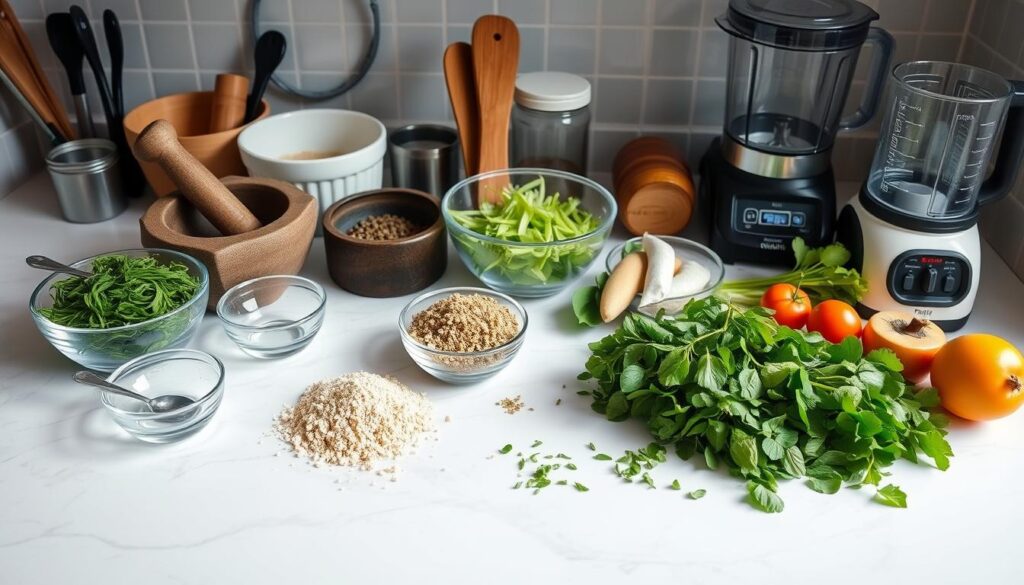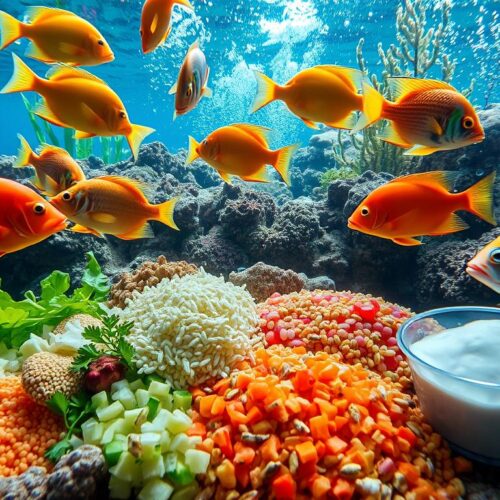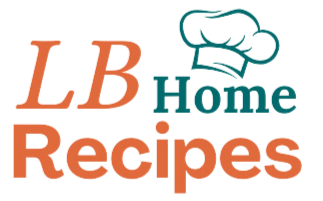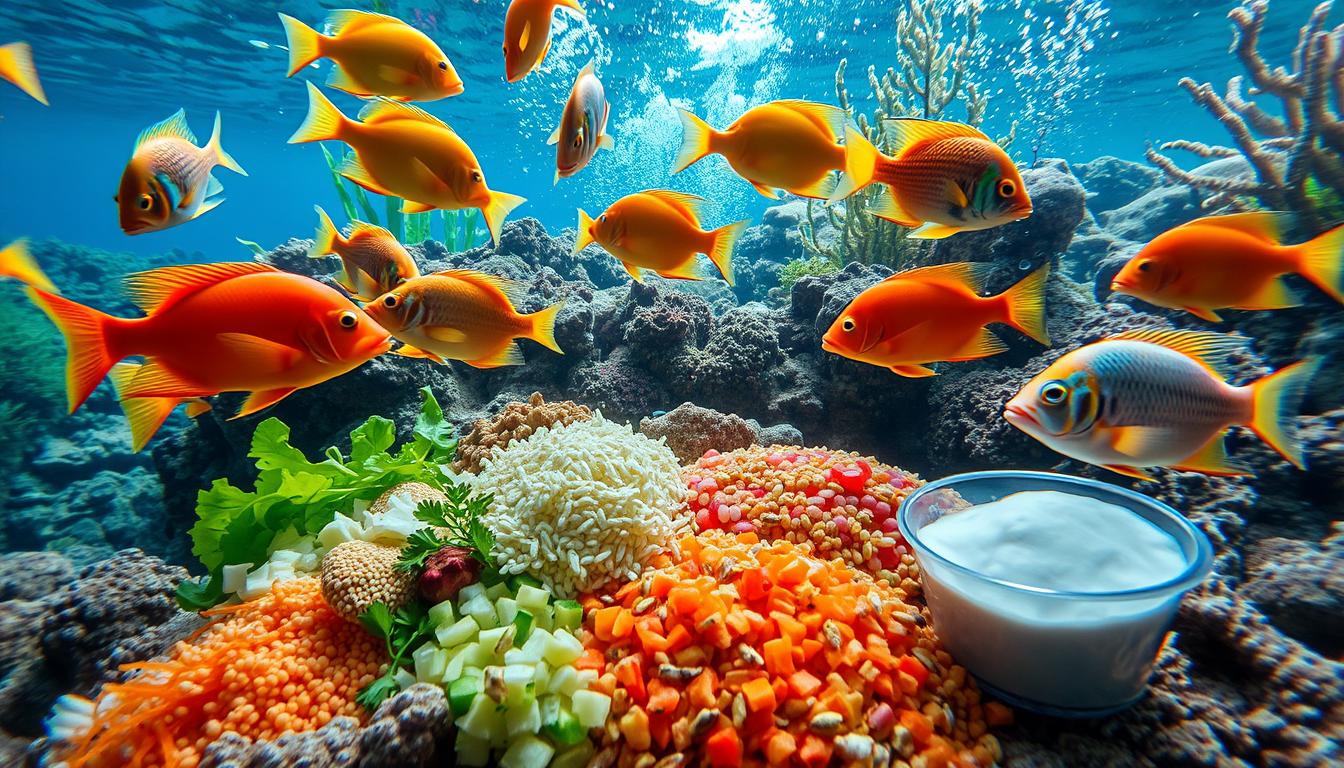As an aquatic pet owner, you know how crucial a balanced diet is for your fish. A homemade fish food recipe can help ensure they get the nutrients they need. With over 71 recipes, you can make healthy meals for your fish. These recipes take about 30 minutes to prepare and offer 179 to 484 calories per serving.
Making fish food recipes can be fun and rewarding. It lets you tailor meals to your fish’s specific needs. You can use fresh ingredients like fish, shrimp, peas, and carrots. This way, you can make tasty and healthy meals for your fish. Whether you’re new to this or looking for something more complex, a guide can help you start.
With a bit of practice and patience, you can make meals that boost your fish’s colors, energy, and life quality. This guide will cover the basics of fish nutrition. We’ll also share recipes and tips for healthy meals and why homemade food is key for your fish. By following these tips, you can create a recipe that meets your fish’s needs and helps them thrive.
Table of Contents
Understanding Fish Nutrition Basics
Knowing the basics of fish nutrition is key to a healthy diet for your fish. Each fish species has its own dietary needs based on size, environment, and type. A balanced diet with proteins, fats, vitamins, and minerals is crucial for their health and growth.
Different fish need different foods. For instance, herbivorous fish like Goldfish need plant-based foods. Carnivorous fish, like Bettas, do well on protein-rich diets. It’s important to match food types to what each fish prefers.
A balanced diet keeps your fish healthy and happy. Choose high-quality fish foods with natural ingredients and avoid artificial stuff. Changing up their diet can prevent boredom and ensure they get all the nutrients they need. How often and how much you feed them depends on their age, size, and activity level.
| Fish Type | Dietary Requirements |
|---|---|
| Herbivorous | Plant-based foods rich in fiber |
| Carnivorous | Protein-rich diets |
| Omnivorous | Balanced mix of plant and animal matter |
By understanding fish nutrition basics, you can give your fish a diet that meets their essential nutrients and dietary needs. This helps them live healthy and happy lives.
Benefits of Homemade Fish Food Recipe
Making homemade fish food is a smart and flexible way to feed your fish. It uses kitchen scraps and cheap ingredients. This way, you can make food that fits your fish’s needs while saving money. Studies show that homemade fish food can cut costs by up to 50% compared to store-bought options.
One big plus of homemade fish food is that you can customize it. You can add special nutrients like spirulina or veggies. This makes the food better for your fish. Plus, you can make a lot at once and keep it for up to three months. This makes it easy for fish owners.
- Cost savings of up to 50% compared to commercial brands
- Customization to meet the specific needs of your fish
- Reduced waste and environmental impact
- Improved nutritional value and fish health
By making homemade fish food, you control your fish’s diet. This ensures they get the nutrients they need to stay healthy. With its cost-effective and customizable benefits, homemade fish food is a great choice for caring for your fish.
Essential Ingredients for Fish Food Recipe
Choosing the right ingredients for fish food is key. A good mix includes protein sources, vegetable components, and other nutrients. Fish meal, squid meal, and shrimp meal are top choices for protein. Spirulina, kelp meal, and wheat germ add fiber, vitamins, and minerals.
Protein sources are vital for fish growth.
Here are some examples:
- Fish meal
- Squid meal
- Shrimp meal
Vegetable components offer fiber, vitamins, and minerals. Some examples are:
- Spirulina
- Kelp meal
- Wheat germ
Other important ingredients include vitamins, supplements, and binding agents. Vitamins and supplements keep fish healthy. Binding agents help mix the ingredients. With the right mix, you can make a nutritious diet for your fish.
Required Tools and Equipment
For fish food preparation, the right tools and equipment are key. You’ll need a blender or food processor to mix the ingredients. Also, storage containers are vital to keep the food fresh.
A mixing bowl and measuring cups are crucial for precise measurements. You might also consider a dehydrator or freezer. These help preserve the food for longer, making it easier to manage your time and budget.
Other helpful equipment includes a coffee grinder for finer powders and a digital scale for exact ingredient weights. With the right tools and equipment, you can prepare fish food safely and efficiently.


- Blender or food processor
- Mixing bowl
- Measuring cups
- Storage containers
- Dehydrator or freezer (optional)
- Coffee grinder (optional)
- Digital scale (optional)
Investing in these basic tools and equipment lets you prepare healthy fish food for your pets.
Basic Fish Food Recipe for Beginners
Starting a basic fish food recipe can seem hard. But, with the right ingredients and steps, you can feed your fish well. A simple recipe includes proteins, veggies, and vitamins.
You’ll need fish meal, spirulina, and veggies like peas and carrots. Fruits like apples and bananas add fiber and vitamins.
Ingredient List
- 1 cup fish meal
- 1/2 cup spirulina
- 1/2 cup peas and carrots
- 1/4 cup apples and bananas
Step-by-Step Preparation
With your ingredients ready, start mixing them in a bowl. Make sure they’re well combined. Then, store the mix in a sealed container in the fridge for up to a week.
Storage Guidelines
Keep your fish food fresh by following storage tips. Store it in a cool, dry spot. Avoid sunlight and moisture.
Advanced Fish Food Recipes for Different Species
As you get better at making fish food recipes, you can try out advanced recipes. These recipes are made for different fish species. Tropical fish need a diet with 30-40% protein for growth and energy. Coldwater fish, like goldfish, do well with less protein, around 20-30%.
It’s key to think about what your fish needs when making recipes. Some fish, like monkfish, have a firm texture. You can add shrimp shells to make a homemade stock for extra flavor.


Here are some tips for making advanced fish food recipes:
* Mix different proteins like fish meal, shrimp, and squid
* Add veggies like peas and carrots for nutrients
* Use binders like gelatin or agar to keep it together
* Try different flavors, like garlic and ginger, for a unique taste
| Species | Protein Requirement | Recommended Ingredients |
|---|---|---|
| Tropical Fish | 30-40% | Fish meal, shrimp, squid |
| Coldwater Fish | 20-30% | Fish meal, peas, carrots |
By following these tips and thinking about your fish’s needs, you can make advanced fish food recipes. These recipes help your fish grow and stay healthy. Always watch how your fish react to new recipes and make changes if needed.
Safety Considerations and Food Hygiene
When making homemade fish food, safety and cleanliness are key. Foodborne illnesses affect millions in the U.S. each year. To keep your fish healthy, follow important storage and hygiene rules.
Keeping fish food clean is crucial. Raw foods should be stored apart from other items. Always refrigerate or freeze perishables quickly.
Key Safety Considerations
- Wash your hands for at least 20 seconds before and after handling food
- Cook fish to an internal temperature of 145°F to ensure food safety
- Store foods in the fridge between 0°C and 5°C to slow bacteria growth
- Avoid cross-contamination by using different chopping boards and utensils for raw and cooked foods
By sticking to these guidelines, you can keep your fish safe. Always focus on cleanliness and proper storage when making fish food at home.
Common Mistakes to Avoid When Making Fish Food
Preparing homemade fish food can be tricky. It’s easy to make mistakes that harm your fish’s health. To avoid these mistakes, it’s key to pick the right ingredients, prepare them correctly, and store them properly. Choosing the wrong ingredients can lead to your fish not getting the nutrients they need.
It’s also important to avoid common preparation mistakes. These can include using low-quality ingredients, overprocessing the food, and not storing it right. Knowing these pitfalls helps you avoid them and keep your fish healthy.
Ingredient Selection Errors
Choosing the right ingredients is crucial when making fish food. The wrong ingredients or the wrong amounts can cause nutritional problems. To avoid this, research what your fish needs and pick ingredients that fit those needs.
Preparation Pitfalls
How you prepare your fish food matters a lot. Over or under processing can reduce nutrients, and poor handling can lead to contamination. To avoid these issues, follow food safety guidelines and handle the food carefully.
Storage Mistakes
Storing fish food wrong can also harm its quality. Improper storage can cause spoilage and nutrient loss. To avoid this, store the food in a cool, dry place and use airtight containers to keep it fresh.
| Common Mistakes | Consequences |
|---|---|
| Incorrect ingredient selection | Nutritional deficiencies |
| Preparation pitfalls | Contamination, spoilage |
| Storage mistakes | Spoilage, contamination |
Monitoring Your Fish’s Response to Homemade Food
When you start giving your fish homemade food, watch how they react. Look at their behavior, how much they eat, and their health. Monitoring fish response helps make sure they’re doing well on their new diet.
A good homemade food mix has proteins, veggies, and grains. For example, Bristlenose Catfish need both plant and protein foods. This mix helps them grow, stay colorful, and full of energy.
Here are some tips for the best results:
- Watch how your fish eat and adjust the food amounts.
- Check the water quality and tweak the recipe if needed.
- Keep a journal of your fish’s health and behavior.
By monitoring fish response and tweaking your recipes, you can give your fish a healthy diet. Always put your fish’s health first. If you’re unsure, ask a vet or aquarium expert for help.
| Fish Species | Dietary Needs |
|---|---|
| Omnivorous Fish | Balanced mix of plant-based and protein-rich foods |
| Herbivorous Fish | Plant-based foods, such as spinach and peas |
| Carnivorous Fish | Protein-rich foods, such as shrimp and fish fillets |
Conclusion: Mastering Your Fish Food Recipe Journey
As you finish your fish food recipe journey, be proud of your progress. Making homemade meals for your fish takes patience, practice, and a commitment to their health. You’ve learned how to make tasty, nutritious meals that keep your fish happy and healthy.
Creating homemade fish food is a journey that never ends. Keep trying new ingredients and adjusting recipes for your fish’s taste. Always focus on food safety and how to store it. With each new batch, you’ll get better at making meals that meet your fish’s needs.
Enjoy the journey, celebrate your wins, and learn from any mistakes. Your fish’s health is the best reward. By putting effort into their meals, you show you care about their well-being and happiness.


Fish Food Recipe
Ingredients
Basic Recipe for Beginners:
- 1 cup fish meal
- ½ cup spirulina powder
- ½ cup mixed peas and carrots blanched
- ¼ cup mashed apples and bananas
Advanced Recipe for Tropical Fish:
- 1 cup fish meal
- ½ cup shrimp blanched and chopped
- ½ cup squid meal
- ¼ cup spirulina powder
- ¼ cup gel binder e.g., gelatin or agar
Optional Additions:
- Garlic or ginger for enhanced flavor
- Vitamin supplements e.g., Vitamin D3 powder
- Omega-3 oil
Instructions
Step 1: Prepare Ingredients
- Measure all ingredients as per your selected recipe.
- Blanch vegetables like peas and carrots to soften them.
- Chop protein sources (like shrimp or squid) into small pieces if required.
Step 2: Blend the Mixture
- Add all measured ingredients into a blender or food processor.
- Blend until a uniform, dough-like consistency forms. Add small amounts of water if necessary for binding.
Step 3: Shape and Portion
- Roll the mixture into small pellets or thin sheets based on your fish’s feeding habits.
- If using a dehydrator, dry the sheets or pellets until firm.
Step 4: Store Properly
- Place the prepared fish food in airtight containers.
- Store in the refrigerator for up to 7 days or freeze for up to 3 months for longer shelf life.
Notes
Nutrition Information (per serving):
- Calories: 179–484
- Protein: 20–30g
- Fat: 5–12g
- Carbohydrates: 15–25g
- Vitamins & Minerals: Vitamin C, Vitamin D, Calcium, Omega-3 Fatty Acids
FAQ
What are the essential nutrients for fish health?
Fish need protein, carbs, and vitamins to stay healthy. Knowing this is key to feeding them right.
How do the dietary needs differ among various fish species?
Different fish have different diets. It’s important to know what your fish needs.
What are the benefits of preparing homemade fish food?
Making your own fish food saves money. You can also tailor it to your fish’s needs.
What are the essential ingredients for fish food recipes?
You’ll need protein, veggies, vitamins, and supplements. Picking the right mix is important for a good diet.
What tools and equipment are required for preparing fish food?
You’ll need blenders, food processors, and containers to make fish food at home.
What is a basic fish food recipe for beginners?
A simple recipe includes ingredients and how to mix them. It also covers how to store the food to keep it fresh.
What are some advanced fish food recipes for different species?
Once you get better at making fish food, you can try recipes for specific fish types.
What safety considerations and food hygiene practices should be followed when making fish food?
Always store food properly and keep it clean. This ensures your fish get safe, nutritious food.
What are common mistakes to avoid when making fish food?
Watch out for mistakes like bad ingredient choices and poor storage. These can ruin your fish food.
How do I monitor my fish’s response to the homemade food?
Keep an eye on how your fish react to the food. Adjust the recipe as needed to keep them healthy.
Your Flavorful Feedback
There are no reviews yet. Be the first one to write one.


1 thought on “Fish Food Recipe Guide: How to Prepare Nutritious Meals”
Comments are closed.